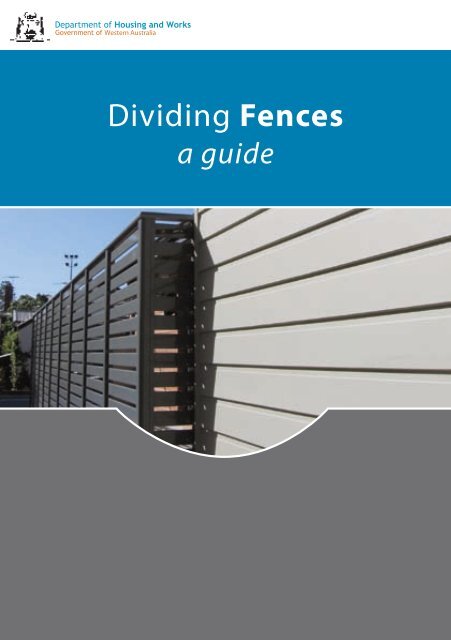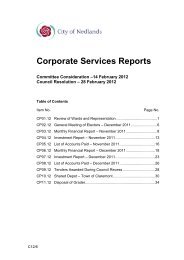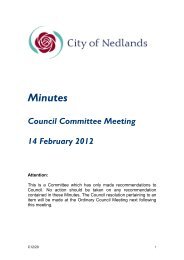Dividing Fences
Dividing Fences
Dividing Fences
- No tags were found...
You also want an ePaper? Increase the reach of your titles
YUMPU automatically turns print PDFs into web optimized ePapers that Google loves.
First thingsto considerFirst things to considerIf you wish to build or repair a dividing fence you need toconsider two things:1. Does the fence and/or associated work require building orplanning approval from your local government?Any substantial structure built along a boundary is likely to requirea building permit from your local government (shire or council).This is particularly the case for retaining walls, walls that form partof buildings, unusually high fences or fences made from unusualmaterials. <strong>Fences</strong> that form part of a swimming pool barrier are alsoregulated by the local government.In many local government areas, brick and masonry fences require abuilding permit. Although simple and conventional dividing fencesmay not need a building permit, you should check with your localgovernment first, as construction without a building permit is anoffence. Local laws may also set out requirements or restrictions onfences, and will define what is a “sufficient fence” in your locality.2. Do you wish to receive a contribution from your neighbour for thecost of building or maintaining the fence?The <strong>Dividing</strong> <strong>Fences</strong> Act 1961 provides for neighbours to share the costof a sufficient dividing fence and provides a mechanism for givingnotice and resolving disputes. You should give the necessary noticeand obtain agreement BEFORE constructing a fence, as the Act onlyallows for recovery of costs afterwards in very limited circumstances.Note: Any agreement, contract or covenant between owners ofadjoining lands on the construction and contribution for adividing fence overrides provisions of the <strong>Dividing</strong> <strong>Fences</strong>Act 1961.dividing fences - a guide 3
What youneed to knowWhat is a dividing fence?A dividing fence, as defined in the <strong>Dividing</strong> <strong>Fences</strong> Act 1961, is a fencethat separates the land of different owners whether the fence is onthe common boundary of adjoining lands or on a line other than thecommon boundary.A dividing fence does not include a retaining wall.The Act does not apply to the Crown or to land used for public purposessuch as roads and paths under the control of local governments. Thismeans that if your property adjoins such land you cannot compel acontribution to the cost of a fence you may wish to build.Sufficient fenceLocal governments may have local laws that prescribe what is asufficient fence. If you want information on what type of fence isallowed in your area, contact your local government.A ‘sufficient fence’ is:•x a fence prescribed by a local government law; or•x a fence of any standard agreed upon by adjoining owners providedthat it does not fall below the standard prescribed by the relevantlocal government law.Where there are no local laws or no agreement is made, a sufficientfence is:•x a substantial fence that is ordinarily capable of resisting the trespassof cattle and sheep; or•x a fence determined by a Magistrates Court to be a sufficient fence.If you want to erect a dividing fence of a higher standard thana sufficient fence and cannot obtain the agreement of theadjoining owner, you may only claim half the cost of erecting andmaintaining a sufficient fence.4dividing fences - a guide
Owners may decide what they want as long as it does not conflict withthe local laws.If your local government does not have any local laws covering fences,you are still obliged to contribute a half share of the construction of asufficient fence. The <strong>Dividing</strong> <strong>Fences</strong> Act 1961 requires that your fencemust be ordinarily able to resist the trespass of cattle or sheep. This doesnot mean that you need to have sheep or cattle on your property, but asa minimum requirement it must be of such a type and strength so thatit can ordinarily resist the trespass of cattle or sheep. Checking out thetype of fencing that has been erected in your area will give you a goodguide as to what is accepted as the fencing standard.Claiming for erecting or maintaininga dividing fenceThe <strong>Dividing</strong> <strong>Fences</strong> Act 1961 provides that owners of adjoining lands areeach liable to pay half the cost of erecting or repairing a ‘sufficient fence’between their properties. The owner of a vacant block can defer makinga contribution until that owner makes useof the block – typically by building on it.An owner wanting to fence a boundarywith an adjoining vacant lot can erect afence without obtaining a contribution,then seek the contribution when theadjoining owner makes use of the block,usually by completing the constructionof a substantial building or structure onthat land. Alternatively an owner can seeka court order for a contribution.dividing fences - a guide 5
If you and your adjoining owner cannot agree, then the use of anindependent mediator may help. Mediation helps to sort out civildisputes in a confidential and non-threatening way. Details of mediationservices available are listed in the Yellow Pages under “Mediators”.Step 2: Court actionThe adjoining owner has 21 days to respond or write back if theydispute all or any part of your proposal. If you are unable to reachan agreement within that time, the matter may be referred to theMagistrates Court nearest to where the fence is situated.The court may decide:•x whether the fence is necessary;•x what type of fence should be built;•x how long it should take to build;•x the boundary upon which the fence is to be built;•x the level of each adjoining owner’s contribution to the fence;•x legal costs; and•x the payment arrangements.The adjoining owner has three months to comply with the agreementyou both made, or to comply with the order which has been made bythe Magistrates Court, unless the adjoining owners agree or the courtorders a different period.If after three months the owner has not complied with the agreementor order, you may erect the fence and recover half of its cost. Contactyour nearest Magistrates Court to find out the procedure for lodging acomplaint with the court or go online at www.justice.wa.gov.au.The court’s decision is final.The Magistrates Court can be contacted on telephone: 9425 2247or visit www.justice.wa.gov.au or www.magistratescourt.wa.gov.audividing fences - a guide 7
Claiming for a fence erectedon vacant landThis section applies only where one or both of the adjoininglots of land is vacant.You may erect a sufficient fence without giving notice or reachingagreement with the owner of the vacant land and still obtain acontribution towards the cost.The owner who has erected the fence may claim from the adjoiningowner whether or not notice was given or an agreement was reached.Except where there is an agreement or a court order, you cannot recoverany of the costs from the owner of adjoining land that is vacant unlessor until the current owner of the adjoining land:(a) has completed a substantial building or structure on the land; or(b)(c)has occupied or occupies a building or structure on the land; orhas permitted or permits some other person to lawfully occupy abuilding or structure on the land.If any of the above conditions are satisfied, you may give the otherowner a notice claiming half the value of the fence as estimated at thedate of claim.An owner or owners of adjoiningland are liable to pay even if theywere not the owners of the landwhen the fence was constructedand no previous adjoiningowners have paid a claim to theowner who erected the fence.8dividing fences - a guide
There is no specified method for determining the value of a fence.Obtaining a current day price for a similar fence may be useful inproviding a base from which to estimate the value of the fence.If it cannot be agreed upon between the adjoining owners, it may benecessary to have the matter decided through mediation or if that fails,in court.The right to claim exists while the person who erected the fence continuesto own the property, however, it is doubtful whether this right exists afterthe property is sold. The commonly held legal view is that the right does notcontinue and this would mean the right to claim cannot be passed onfrom the owner who erected the fence to another owner who buys theirland.If the adjoining owner gives you written notice of objection andagreement cannot be reached on the claim, you may make acomplaint to the Magistrates Court nearest to where the fence issituated. Complaint forms are available from the court or online atwww.justice.wa.gov.au.The court will make a decision on the dispute.dividing fences - a guide 9
Repair ofdividing fencesThe <strong>Dividing</strong> <strong>Fences</strong> Act 1961 provides for owners of land on either sideof the fence to join in or contribute in equal proportions to the repair ofthe fence. This applies to both developed and vacant land.The Act defines the word “repair” as including “realign and re-erect” sothe provisions which deal with repairing a dividing fence also apply inthe same way to fences which need re-erection or realignment.It is important to determine whether the condition of the existing fencejustifies it being replaced by the same type of fence.If you wish to have a dividing fence repaired, you should give theadjoining owner a notice describing the kind and extent of repairs to bemade, and stating that you are prepared to:•x repair the fence and pay half the cost if the other owner will also payhalf the cost;•x permit the other owner to repair the fence and you will pay half thecost; or•x pay half the cost of having the fence repaired by a third party.Note: “Cost” may include labour, equipment hire and materials.The other owner or owners have 14 days to object. They must notifyyou in writing of the objection. If they object, you may apply to theMagistrates Court nearest to where the fence is situated for an order.If they do not object within 14 days you may repair the fence. If acontribution is not made you will be able to recover half the cost ofrepairs from the other adjoining owner or owners by referring thematter to the Magistrates Court.If the adjoining owner or owners object or do not agree to pay, youmust apply to the Magistrates Court for an order. Where the adjoiningowners have agreed to the repair or the court has ordered the repair,both owners must allow access to enable the dividing fence to berepaired.10dividing fences - a guide
SPECIAL CASES•x If the dividing fences was built partly by one neighbour, and partly bythe other neighbour, each neighbour is responsible for the costof repairing the part of the fence he or she built.Redevelopment of propertiesIf your adjoining owner redevelops his/her land by demolishing existingbuildings or erecting new ones, he/she may ask for a contribution for anew fence.This may occur if the existing fence is of a lower standard than asufficient fence, is erected other than on the boundary line or is in needof repair or replacement. It may also occur because the adjoining ownerwants a new fence.Development approvals by some local governments require thedeveloper to build new fences or require that they be to the localgovernment’s satisfaction.This does not prevent the adjoining owner from serving notice underthe Act on the other owner seeking a contribution for half the fenceconstruction or repair costs.For a claim to be successfulit will depend on whetherthe fence was in acondition requiring itsreplacement.dividing fences - a guide 11
Repairingwithout noticeWhere a dividing fence is damaged or destroyed in whole orin part by flood, fire, lightning, storm, tempest or accident, theowner on either side of the fence may immediately repair thefence without notice. The party who repaired the fence is thenentitled to recover half of the expenses of doing so from theowner of the adjoining land through the Magistrates Court.However, it is suggested that despite this right of action, it is betterto try to give notice of your intention to repair the fence. Try to reachagreement on payment for repairs before taking court action.What happens if the fence is damaged by yourneighbour?Situations may arise where you consider that your neighbour orneighbours should be paying for the entire repair of the fence becauseit has been damaged by their actions or inaction.The Act only recognises a limited set of circumstances where an adjoiningowner or owners who are at “fault” are bound to repair or renew a dividingfence at their cost. These are where the dividing fence is damaged ordestroyed in whole or in part by fire, or by the falling of any tree (or portionthereof ). An element of neglect on the part of the adjoining owner or ownersfrom whose land the fire originated or the tree fell must also be evident.For all other fence damage the adjoining owners are liable to join in andcontribute in equal proportions to the repairs.If your neighbours are bound to repair the dividing fence, at their cost,according to the above, and fail to do so, you as the adjoining owner mayrepair or renew the fence. You may then recover the whole cost of doing sofrom your neighbours by referring the matter to the Magistrates Court.It is better to maintain harmony with neighbours by first negotiatingwith them to repair the fence.12dividing fences - a guide
Tenant andlandlordSpecial rules apply to tenants and landlords. As a tenant you do nothave to pay for the cost of construction or repair of a dividing fenceunless the term of the lease is for a period of five years or more.If the term of the lease is betweenfive and seven years, the landlordmust pay three quarters of the costand the tenant one quarter.Example (a)Total cost of constructionor repair $400Half cost to each owner = $200 eachLandlord’s share $150Tenant’s share +$ 50=$200If the term of the lease is betweenseven and twelve years, the landlordand the tenant must each pay onehalf of the cost of construction orrepair of the dividing fence.Example (b)Total cost of constructionor repair $400Half cost to each owner = $200 eachLandlord’s share $100Tenant’s share +$100=$200If the term of the lease is longerthan 12 years the tenant must paythe whole of the cost.Example (c)Total cost of constructionor repair $400Half cost to each owner = $200 eachLandlord’s share$ NilTenant’s share +$200=$200In this explanation, the cost is half the total cost of construction or repair ofthe dividing fence. This follows the general rule that each adjoining owneris to pay half the total cost of construction or repair of a dividing fence.dividing fences - a guide 13
Strata titlesWhere adjoining land is owned under a strata title, a claimmay still be made against the owners for a contribution forconstructing or repairing a dividing fence.The owners of the strata title land may be:•x the strata company; or•x another person, depending on the nature of the strata scheme and theby-laws of the strata company. It will also depend on whether a personhas lodged a notice for recording on the strata/survey-strata plan withthe Registrar of Titles in accordance with section 123A(3) of the StrataTitles Act 1985 (WA).The name of the strata company and information about this type of stratascheme, the by-laws of the strata company and whether a notice has beenrecorded on the strata/survey-strata plan can be obtained from the CustomerServices Branch of Landgate, 1 Midland Square, Midland WA, Phone: 9273 7373.Note:There are fees payable for this information.14dividing fences - a guide
Liability for upkeep and maintenance of dividing fences– strata titleFor most schemes (single tier strata schemes and survey-strataschemes), unless an objection has been lodged or a law has beenregistered on the plan, then:•x if the fence divides a strata lot and the adjoining property (which isnot part of the scheme), the owners of the strata lot and the adjoiningproperty are liable;•x if the fence divides common property and the adjoining property(which is not part of the scheme), the strata company and the ownerof the adjoining property are liable;•x if the fence divides two (2) lots in the strata scheme, the owners ofthose lots are equally liable;•x if the fence divides a lot and common property in the scheme, theowner of the lot and the strata company are liable;In other schemes (for example in a multi storey scheme), the stratacompany and the owner of the adjoining land are equally liable forthese costs.dividing fences - a guide 15
Negotiating withyour neighbourAlthough informal discussions are okay, it is better to haveagreements in writing. This clears any ambiguity and clarifies anypoint of difference. It can also be used later to show what has beenagreed if the matter comes before mediation, arbitration or thecourts. Note that agreements between owners with regard to thecost of erecting or repairing dividing fence override the Act.It is in both neighbours’ interests to attempt to resolve dividing fencesmatters between themselves in a courteous and friendly manner. The<strong>Dividing</strong> <strong>Fences</strong> Act 1961 encourages agreement between owners ofadjoining land, and any such agreement overrides the Act.There are many steps that can be taken to reach agreement with aneighbour to provide for dividing fences. These include:•x approaching your negotiation with an appropriate communicationstyle;•x identifying key needs you would like to have met. Recognise yourneighbour may have competing needs,try to acknowledge these;•x starting the negotiation with a positivestatement about your mutual needs;•x gaining agreement on common groundduring the negotiation, this will helpidentify the points of difference betweenyou and your neighbour;•x being aware that you may havean ongoing relationship with yourneighbour – be reasonable, pushing toohard or becoming adversarial will alienateyour neighbour and possibly harm your future relationship;•x recognising that you have not only dividing fences rights, but alsoresponsibilities;•x remembering that where both parties are satisfied, each will workto make the agreement and relationship succeed.16dividing fences - a guide
Entering your neighbour’s propertyWhere an agreement or court order exists, or where the provisions ofthe Act are being followed, a contractor or person erecting or repairinga fence has access to the adjoining property. This access is “at allreasonable times” to effect the erection or repair of a dividing fence.Before repairing or constructing a fence,you should:•x inform your neighbour of what you aredoing;•x tell them that you may need to go ontotheir land to construct or repair thefence; and•x obtain your neighbour’s agreementbefore undertaking any work relatingto dividing fences.You should be careful not to enter onto,or interfere with your neighbour’s propertyunless it is necessary to carry out the work.Legal adviceWhere you have failed to obtainagreement with an adjoining owner, it may be advisable to obtain legaladvice before making any commitments or carrying out any fencing orassociated work that would involve significant cost or before startinglegal proceedings.dividing fences - a guide 17
Other mattersto be aware ofWalls constructed adjacent to lot boundariesThese walls, such as a house wall, garage wall, parapet wall and a shedor the like, are built solely on one property under a building licence andbelong to the owner who constructed the wall.Responsibility for construction and maintenance rests with the owner ofthe land on which it is constructed.An adjoining owner is not permitted to paint, render or attach anything(such as pot plants, clotheslines and basketball hoops) to the wall withoutthe permission of the owner of the wall. It is suggested that any suchpermission be in writing.A boundary wall is not a dividing fence and either adjoining landownercan still erect a sufficient fence along the boundary line.Tree debris, encroaching roots and overhangingbranchesTrees are a highly desirable part of our landscape and essential to ourenvironment so a certain amount of inconvenience associated withthem should be tolerated.Information on your rights about tree nuisance is available online at:www.legalaid.wa.gov.au/InfoAboutLaw.You should be aware that these issues are not covered under the<strong>Dividing</strong> <strong>Fences</strong> Act 1961.Only where a dividing fence has been destroyed in whole or in part by thefalling of a tree does the Act provide for the adjoining owner to repair thefence immediately and recover the costs in the Magistrates Court.Under Schedule 3.1 of the Local Government Act 1995, your localgovernment may serve a notice on owners of land to ensure that a tree onthat land that endangers any person or thing on adjoining land is madesafe. Contact your local government authority for more information.18dividing fences - a guide
<strong>Fences</strong> constructed adjacent to a dividing fenceSituations may arise where property owners wish to construct a fenceon their own land adjacent to an existing dividing fence. The Actdoes not prevent this second fence from being erected, however, itis recommended that you contact your local government to find outwhether it has any restrictions on structures of this type.Your adjoining owner may still seek your contribution for maintainingthe existing dividing fence, even where you erect a second fence onyour property adjacent to it.Your privacyIf the dividing fence does not provide adequate privacy, contact yourlocal government for more information on their local fencing laws.Some local governments permit the use of lattice attached to a fence orallow you to erect a privacy/garden screen as a separate structure fromthe fence.dividing fences - a guide 19
Swimming poolbarriers20Requirement to have a safety barrierWestern Australia has legislation to restrict unsupervised access to a privateswimming or spa pool by young children. If the structure contains water to adepth greater than 300mm and is meant for swimming, wading, bathing orlike activities then the structure is required to have a barrier installed.Private swimming pools are required to be isolated using appropriatesafety barriers (e.g. fencing, gates, walls, enclosed in a building) thatmust comply with Part 10 of the Building Regulations 1989. Generally,swimming pools are required to be isolated by fencing unless otherwisepermitted by the Regulations.For swimming pools installed before 5 November 2001:•x access from adjoining properties and from the road is to be protected;•x access from the house to the pool is to be protected, by ensuring alldoors and windows leading from the house to the pool area are inaccordance with Australian Standard 1926.1;•x any gates allowing entry into the pool area must swing in a directionother than towards the pool area.For swimming pools installed on or after 5 November 2001 the followingadditional requirements also apply:•x access from the house to the pool is to be protected by a barrier fenceand by ensuring all windows that are along a wall of the house that form abarrier to the pool area are in accordance with Australian Standard 1926.1;•x doors leading from the dwelling to the pool area are not permitted, unlessexempted by the Regulations and approved by the local government.Local governments are required to inspect and ensure compliance ofthese barriers at least every four years.A portable wading pool that is capable of being filled with water toa depth of no more than 300mm does not need to have a barrier.Regardless of the barrier requirements, homeowners and parents need tobe aware that although these types of pools do not require a mandatorychild safety barrier, they are still dangerous to young children.dividing fences - a guide
Barrier design and constructionThe design and construction of barriers must be such that they complywith the requirements of Australian Standards 1926.1 - 1993 - (Fencingfor swimming pools).Legislation in Western Australia requires that the installed barriers aremaintained in compliance with the Australian Standard at all times. If thebarrier does not comply with the requirements, upon local governmentinspection, infringement notices may be issued.Penalties for non-compliancePenalties for non-compliance can range from on-the-spot fines issuedby local government to court imposed penalties if:•x an appropriate barrier is not installed; or•x under inspection, parts of the barrier are found not to comply.Under inspection, a local government may:•x impose a penalty of $100 without first issuing a defect/compliancenotice;•x impose a penalty of $200 if a defect/compliance notice has beenissued to the occupier, and should the pool owner/occupier fail tocomply with a defects/compliance notice; or•x begin legal proceedings, where a maximum penalty of $5,000 andpenalty of $250 for each day may applyuntil the barrier is deemed to comply.For more information aboutswimming pool barriers,contact your local governmentor download a brochure at:http://www.dhw.wa.gov.au/193_361.aspdividing fences - a guide 21
Giving noticeto fenceSample Letter(Your address)Dear NeighbourI am writing to advise that I propose to erect a dividingfence on the boundary line between our properties (includeproperty addresses).The fence I wish to erect is a (specify here the description ofthe fence, ie. type, height, material and the boundary line tobe fenced).I have obtained quotes (copies attached) and propose toaccept the quote from (fencing company - eg. ABC FencingCompany) for (amount - eg. $400). Your share of the dividingfence will be (half of the cost - eg. $200) which is half the costof a sufficient fence according to the local government lawsin the area.Please let me know within 21 days if you agree or disagreewith this proposal.If you would like to discuss this with me I can be contacted ontelephone number (your number) or by email at (your emailaddress).If within 21 days we cannot reach agreement or you do notrespond, the <strong>Dividing</strong> <strong>Fences</strong> Act 1961 provides for the matterto be determined in the Magistrates Court.sample(Your signature, name and date)22dividing fences - a guide
Giving noticeto fenceSAMPLE FORMGiving Notice to Fence - Western Australiadate.........................................To my Neighbour.................................................Address.............................................................................................................................................From................................................................Address............................................................Phone............................................................................................................................................Dear NeighbourEmail................................................................I would like to fix/erect the dividing fence on the boundary line between our properties and hope thatyou will share the costs with me.The fence is located between my land (address)................................................................................and your land (address)......................................................................................................................Length of Fence.........................................................Height of fence.................................................Type of fence......................................................................................................................................Attached is copy of the quotes I have obtained.The total cost of the fence from ..............................................including GST is $.............................Your half share of a sufficient fence according to the local government laws in the area includingsampleGST is $..................................If within 21 days of receiving this notice you do not agree to *repair or *replace (*delete one) ouradjoining fence I will apply as per the <strong>Dividing</strong> <strong>Fences</strong> Act 1961 to a Magistrates Court for an orderthat describes the type of fence to be constructed and how much each party will contribute.Yours sincerely signed..................................................................I..................................................of....................................................................................acknowledgereceipt of this ‘fencing notice’ and agree to *repair or *replace (*delete one) the dividing fence onthe boundary line between our properties as proposed.I will pay my share of $............................................................. to *you or *the fencer. (*delete one)Yours sincerely signed......................................................................................................................Print Name .............................................................................Date...................................................This form can be printed out from the website: www.dhw.wa.gov.auDisclaimer: this form provides general guidance and information only andis current at time of printing. The State of Western Australia and its servantsand agents expressly disclaim liability, whether in negligence or otherwise,for any act or omission resulting from reliance on this document or for anyconsequence of such act or omission.dividing fences - a guide 23
Frequentlyasked questionsMy neighbour’s trees are pushing against the fence and have 36damaged it. I have asked that he cut the trees down or at leastcut them back and repair the fence at his cost. He advised that asfar as he is concerned the trees stay and that he will only pay halfthe cost of the repair. What are my rights?Do I have to contribute to the repair of the dividing fence if my land 36is vacant?The neighbouring property is owned by the Department of 36Housing and Works (DHW) and the fence is in need of repair,what should I do?28dividing fences - a guide
Frequentlyasked questionsProcedures for erecting a new fenceDo I need my adjoining neighbour’s agreement before I erect a newfence?If you wish to claim a contribution and the adjoining land is not vacant,there must be an agreement or a court order in place before erectingthe fence.Where the adjoining land is vacant, you do not need an agreement. Ifyou do not obtain agreement, a claim for a contribution to the fence canbe made on the owner when there is a substantial building erected onthe land, or when the land owner occupies or permits the occupation ofany building on the land.You do not need an agreement if you want to erect the fence entirely atyour own expense, and forego any right to contribution under the Act.The fence you erect must still be a “sufficient fence”.If you decide to erect a fence at your own expense, it is recommendedthat you give the adjoining owner the details of the proposal as acourtesy, and to enable them to make arrangements to protect theirproperty or animals, etc during the construction process. A decision toerect a fence entirely at your own cost does not give you the right toenter the adjoining owner’s property without their permission duringthe erection of the fence.Do I have to have more than one quote to give to my neighbourwhen I approach him looking for his half payment to a new fence?The Act does not specify a requirement for the obtaining of quotes butit is suggested that you should try to obtain at least two written quotes.dividing fences - a guide 29
Frequentlyasked questionsClaiming for a fence erected on vacant landThe land next door is vacant but they have started building on it.How much of the building must be constructed before I can make aclaim for half the cost of the fence?Under section 13 of the <strong>Dividing</strong> <strong>Fences</strong> Act 1961, you can make a claimwhen a substantial building has been completed.This should not beconfused with a building that is substantially completed. It is only oncethe building is complete that you may make a claim under this sectionof the Act.How much time does the adjoining owner have to pay me myclaim for half the fence cost now that a substantial building has beencompleted on his land?The adjoining owner is required to pay within one month of the receiptof your claim. You may enter into an agreement with your neighbour toallow a longer time period or agree to accept payment by instalments.Such agreement should be in writing and signed and dated by bothparties.I built the dividing fences on my property when the adjoining landwas vacant. There is now a substantial building erected on thevacant land and I want to now claim my share of the fencing. Howmuch can I claim?You may give the adjoining owner a notice claiming half the valueof a sufficient fence as estimated at the date of claim.Note: This is not the same as current day market price for the fence,although the obtaining of a current day price for a similar fence may beuseful in providing a base from which to estimate the value of the fence.dividing fences - a guide 31
Frequentlyasked questionsDo I have to contribute to the cost of a fence when my land is stillvacant?No, not unless you have agreed to contribute before the fence iserected or unless the adjoining owner obtains a court order, beforethe fence is erected, requiring you to contribute.My lot was vacant and my neighbour has constructed a brickfence, do I have to pay for half of it?No, not unless the sufficient fence (minimum standard) for a fencein that location is a brick fence. The minimum standard could be asa result of the local government’s fencing local law or town planningscheme, or through a condition of sale imposed by the developer as acovenant. You would as a general rule have to contribute half the costof a sufficient fence, this being the minimum standard required by yourlocal government.I am about to build and do not like the fence my neighbour justerected, and I do not want to pay him anything. Can I do this?If the fence that is erected is a sufficient fence, ie. acceptable to the localgovernment and in keeping with other fences in the immediate area,the adjoining landowner who erected it has a legal right under the<strong>Dividing</strong> <strong>Fences</strong> Act 1961 to claim half payment of a sufficient fence whenyou complete your building.My neighbour built his house first and erected a fence that I did notlike. I wanted a green colorbond and he erected a wooden one. I havesince built my house and erected a fence on my land. My neighbourhas now given me a bill for the fence he erected. Do I have to pay?Yes, the original fence is the dividing fence and you would be requiredto pay half the cost of it and also bear responsibility for a half share of theongoing maintenance costs of the dividing fence. The cost for the erectionand ongoing maintenance of the second fence would be yours entirely.32dividing fences - a guide
Frequentlyasked questionsMy neighbour has claimed from me half the cost of the dividingfence he erected. I am the second owner of the property and feelthat he should have got his money from the previous owner. Am Iliable to pay the money claimed?Yes, an owner or owners of adjoining land are liable to pay even ifthey were not the owners of the land when the fence was constructed,provided that no previous adjoining owners had paid a claim to theowner who erected the fence.My neighbour and I are at about the same stage of building ourhouses. He wants a metal fence and I want a fibrous cement one thatgoes into the ground. I have a dog to contain and he could easily digunder a metal one. What can do about this?The best way to erect a fence is by agreement with the adjoining owner.You should first try to resolve any differences by discussing the matterwith the owner. You may wish to consult a mediator, who can assist youin resolving differences, before going to court.If the owners cannot agree, the matter may be determined in theMagistrates Court.My neighbour’s fence is 10 years old. Do I have to pay for the halfvalue of the fence when it was constructed or what it is worth now?The requirement is for payment of half the value of the fence as at thedate of claim. The person making the claim has to estimate the value.If your neighbour erected a fence of a higher standard than a sufficientfence, as defined by your local government, unless you agreed to pay thehigher cost, you would only have to pay half the cost of a sufficient fence.If for example, a metal fence was erected and the sufficient fence,as defined by your local government, is a fibrous cement one, theobligation is for payment of half the cost of the lesser standard fence,being the fibrous cement one. The additional cost for the higherstandard fence would be borne by the adjoining owner that requires it.dividing fences - a guide 33
Frequentlyasked questionsI have had my land surveyed and it shows that the dividing fenceis out of alignment and my adjoining owner has some of my land.Who pays for the cost of the relocation of the fence onto the correctboundary and what steps should be followed to shift the fence?The <strong>Dividing</strong> <strong>Fences</strong> Act 1961 in defining what a repair is, includes therealignment or re-erection of a fence. This means that the cost is liableto be shared equally by the adjoining land owners. The process forseeking a realignment of a fence is covered by Section 15 of the Act.Our dividing fence is an old picket fence that needs to be replaced.I want to put up a new brick fence. If I do so, what procedures do Ineed to follow?The <strong>Dividing</strong> <strong>Fences</strong> Act 1961 only applies to the erection of the firstfence and then its repair. Replacing an existing fence with an entirelydifferent type of fence is regarded as the erection of a new fence. Thusthe procedure for erecting a fence must be followed where a fence isreplaced with an entirely different one (refer to step 1 – giving notice).If an old fence is replaced with a new fence that is the same as the oldfence, it is classified as a repair, and the procedures relating to repairingfences must be followed.I believe that the dividing fence is fine and can be simply repairedin a few places and maybe realigned and straightened up a bit. Myneighbour does not agree and told me he wants a new one. Do Ihave to pay half for a new fence just because he wants it?No, you would not have to pay for a new fence unless you agree tothis or your neighbour takes you to court and is successful in obtainingan order for you to contribute to a new fence. In such a dispute, it wouldbe necessary for the owner taking the legal action to prove that thefence is in need of replacement and cannot or should not be repaired.That owner would then generally seek to support such a case throughthe presentation to the court with photographs and testimony fromexpert witnesses.dividing fences - a guide 35
Frequentlyasked questionsMy neighbour’s trees are pushing against the fence and havedamaged it. I have asked that he cut the trees down or at least cutthem back and repair the fence at his cost. He advised that as far ashe is concerned the trees stay and that he will only pay half the costof the repair. What are my rights?You would be required under the <strong>Dividing</strong> <strong>Fences</strong> Act 1961 tocontribute to half the cost of the repairs to the fence. If you refuseto pay your neighbour may seek a court order.Do I have to contribute to the repair of the dividing fence if my landis vacant?Yes, subject to Part III Section 15 of the <strong>Dividing</strong> <strong>Fences</strong> Act 1961.The neighbouring property is owned by the Department ofHousing and Works (DHW) and the fence is in need of repair,what should I do?State government departments are not bound by the <strong>Dividing</strong> <strong>Fences</strong>Act 1961, however you should contact your nearest DHW office todiscuss the repair or replacement options.36dividing fences - a guide
Useful contactnumbers and linksCitizens Advice Bureau 9221 5711(Access to community lawyers/mediators- small fee)www.cabwa.com.auemail: cab@cabwa.com.auMagistrates Court 9425 2247(To resolve civil disputes in a court of law)www.justice.wa.gov.au or www.magistratescourt.wa.gov.auLandgate 9273 7341(Land title searches, adverse possession information)www.landgate.wa.gov.auemail: mailroom@landgate.wa.gov.auHealth Department 9222 4222(Environmental Health Branch – asbestos issues)www.population.health.wa.govDepartment of Local Government 9217 1500and Regional Development(To obtain a contact number for your local government office)www.dlgrd.wa.gov.auemail: info@dlgrd.wa.gov.auState Law Publisher 9321 7688(To view legislation )www.slp.wa.gov.auemail: sales@dpc.wa.gov.audividing fences - a guide 37
Further information on <strong>Dividing</strong> fencescall: 1300 720 715email: dividingfences@dhw.wa.gov.auThis booklet is available online at: www.dhw.wa.gov.auDHW136 1008












